Jiyoung Kim
MATRIX: Mask Track Alignment for Interaction-aware Video Generation
Oct 08, 2025Abstract:Video DiTs have advanced video generation, yet they still struggle to model multi-instance or subject-object interactions. This raises a key question: How do these models internally represent interactions? To answer this, we curate MATRIX-11K, a video dataset with interaction-aware captions and multi-instance mask tracks. Using this dataset, we conduct a systematic analysis that formalizes two perspectives of video DiTs: semantic grounding, via video-to-text attention, which evaluates whether noun and verb tokens capture instances and their relations; and semantic propagation, via video-to-video attention, which assesses whether instance bindings persist across frames. We find both effects concentrate in a small subset of interaction-dominant layers. Motivated by this, we introduce MATRIX, a simple and effective regularization that aligns attention in specific layers of video DiTs with multi-instance mask tracks from the MATRIX-11K dataset, enhancing both grounding and propagation. We further propose InterGenEval, an evaluation protocol for interaction-aware video generation. In experiments, MATRIX improves both interaction fidelity and semantic alignment while reducing drift and hallucination. Extensive ablations validate our design choices. Codes and weights will be released.
K/DA: Automated Data Generation Pipeline for Detoxifying Implicitly Offensive Language in Korean
Jun 16, 2025Abstract:Language detoxification involves removing toxicity from offensive language. While a neutral-toxic paired dataset provides a straightforward approach for training detoxification models, creating such datasets presents several challenges: i) the need for human annotation to build paired data, and ii) the rapid evolution of offensive terms, rendering static datasets quickly outdated. To tackle these challenges, we introduce an automated paired data generation pipeline, called K/DA. This pipeline is designed to generate offensive language with implicit offensiveness and trend-aligned slang, making the resulting dataset suitable for detoxification model training. We demonstrate that the dataset generated by K/DA exhibits high pair consistency and greater implicit offensiveness compared to existing Korean datasets, and also demonstrates applicability to other languages. Furthermore, it enables effective training of a high-performing detoxification model with simple instruction fine-tuning.
MT3DNet: Multi-Task learning Network for 3D Surgical Scene Reconstruction
Dec 05, 2024Abstract:In image-assisted minimally invasive surgeries (MIS), understanding surgical scenes is vital for real-time feedback to surgeons, skill evaluation, and improving outcomes through collaborative human-robot procedures. Within this context, the challenge lies in accurately detecting, segmenting, and estimating the depth of surgical scenes depicted in high-resolution images, while simultaneously reconstructing the scene in 3D and providing segmentation of surgical instruments along with detection labels for each instrument. To address this challenge, a novel Multi-Task Learning (MTL) network is proposed for performing these tasks concurrently. A key aspect of this approach involves overcoming the optimization hurdles associated with handling multiple tasks concurrently by integrating a Adversarial Weight Update into the MTL framework, the proposed MTL model achieves 3D reconstruction through the integration of segmentation, depth estimation, and object detection, thereby enhancing the understanding of surgical scenes, which marks a significant advancement compared to existing studies that lack 3D capabilities. Comprehensive experiments on the EndoVis2018 benchmark dataset underscore the adeptness of the model in efficiently addressing all three tasks, demonstrating the efficacy of the proposed techniques.
Appearance Matching Adapter for Exemplar-based Semantic Image Synthesis
Dec 04, 2024



Abstract:Exemplar-based semantic image synthesis aims to generate images aligned with given semantic content while preserving the appearance of an exemplar image. Conventional structure-guidance models, such as ControlNet, are limited in that they cannot directly utilize exemplar images as input, relying instead solely on text prompts to control appearance. Recent tuning-free approaches address this limitation by transferring local appearance from the exemplar image to the synthesized image through implicit cross-image matching in the augmented self-attention mechanism of pre-trained diffusion models. However, these methods face challenges when applied to content-rich scenes with significant geometric deformations, such as driving scenes. In this paper, we propose the Appearance Matching Adapter (AM-Adapter), a learnable framework that enhances cross-image matching within augmented self-attention by incorporating semantic information from segmentation maps. To effectively disentangle generation and matching processes, we adopt a stage-wise training approach. Initially, we train the structure-guidance and generation networks, followed by training the AM-Adapter while keeping the other networks frozen. During inference, we introduce an automated exemplar retrieval method to efficiently select exemplar image-segmentation pairs. Despite utilizing a limited number of learnable parameters, our method achieves state-of-the-art performance, excelling in both semantic alignment preservation and local appearance fidelity. Extensive ablation studies further validate our design choices. Code and pre-trained weights will be publicly available.: https://cvlab-kaist.github.io/AM-Adapter/
MoDiTalker: Motion-Disentangled Diffusion Model for High-Fidelity Talking Head Generation
Mar 28, 2024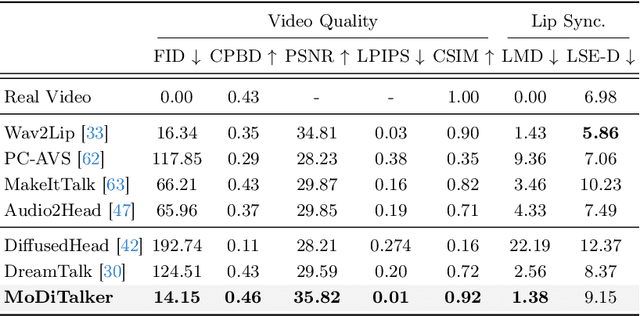
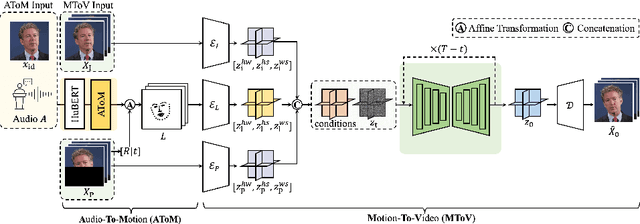

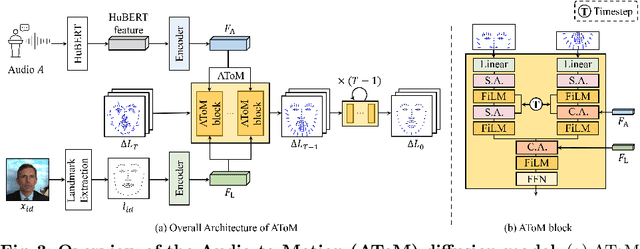
Abstract:Conventional GAN-based models for talking head generation often suffer from limited quality and unstable training. Recent approaches based on diffusion models aimed to address these limitations and improve fidelity. However, they still face challenges, including extensive sampling times and difficulties in maintaining temporal consistency due to the high stochasticity of diffusion models. To overcome these challenges, we propose a novel motion-disentangled diffusion model for high-quality talking head generation, dubbed MoDiTalker. We introduce the two modules: audio-to-motion (AToM), designed to generate a synchronized lip motion from audio, and motion-to-video (MToV), designed to produce high-quality head video following the generated motion. AToM excels in capturing subtle lip movements by leveraging an audio attention mechanism. In addition, MToV enhances temporal consistency by leveraging an efficient tri-plane representation. Our experiments conducted on standard benchmarks demonstrate that our model achieves superior performance compared to existing models. We also provide comprehensive ablation studies and user study results.
Expand-and-Quantize: Unsupervised Semantic Segmentation Using High-Dimensional Space and Product Quantization
Dec 12, 2023Abstract:Unsupervised semantic segmentation (USS) aims to discover and recognize meaningful categories without any labels. For a successful USS, two key abilities are required: 1) information compression and 2) clustering capability. Previous methods have relied on feature dimension reduction for information compression, however, this approach may hinder the process of clustering. In this paper, we propose a novel USS framework called Expand-and-Quantize Unsupervised Semantic Segmentation (EQUSS), which combines the benefits of high-dimensional spaces for better clustering and product quantization for effective information compression. Our extensive experiments demonstrate that EQUSS achieves state-of-the-art results on three standard benchmarks. In addition, we analyze the entropy of USS features, which is the first step towards understanding USS from the perspective of information theory.
Depth-Relative Self Attention for Monocular Depth Estimation
Apr 25, 2023Abstract:Monocular depth estimation is very challenging because clues to the exact depth are incomplete in a single RGB image. To overcome the limitation, deep neural networks rely on various visual hints such as size, shade, and texture extracted from RGB information. However, we observe that if such hints are overly exploited, the network can be biased on RGB information without considering the comprehensive view. We propose a novel depth estimation model named RElative Depth Transformer (RED-T) that uses relative depth as guidance in self-attention. Specifically, the model assigns high attention weights to pixels of close depth and low attention weights to pixels of distant depth. As a result, the features of similar depth can become more likely to each other and thus less prone to misused visual hints. We show that the proposed model achieves competitive results in monocular depth estimation benchmarks and is less biased to RGB information. In addition, we propose a novel monocular depth estimation benchmark that limits the observable depth range during training in order to evaluate the robustness of the model for unseen depths.
Towards Intelligent Millimeter and Terahertz Communication for 6G: Computer Vision-aided Beamforming
Sep 06, 2022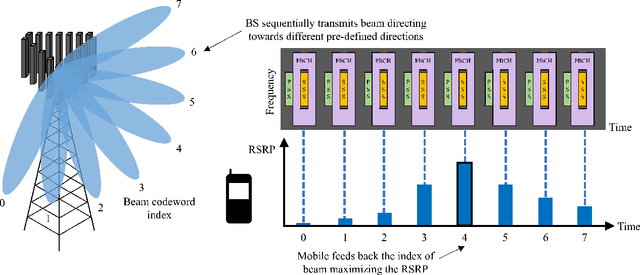
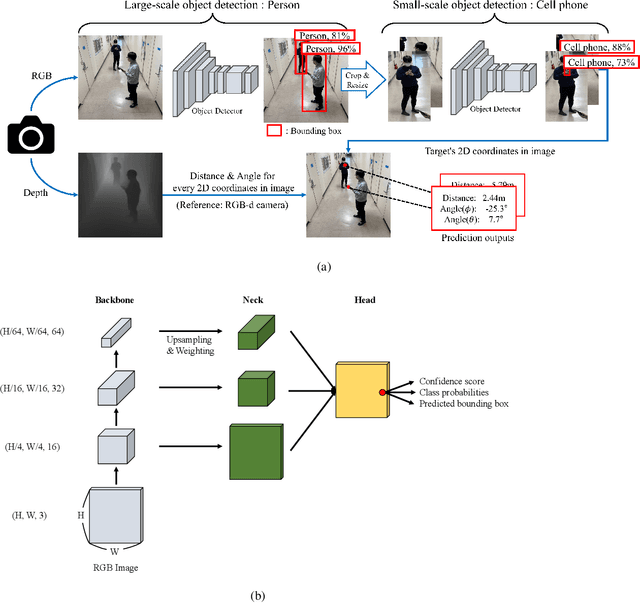
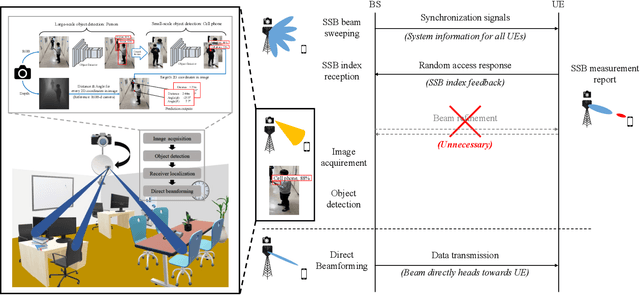
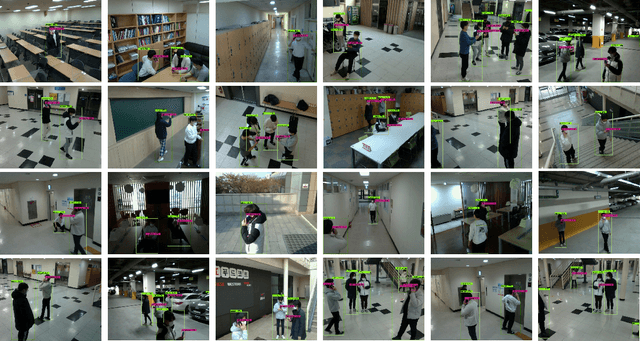
Abstract:Beamforming technique realized by the multiple-input-multiple-output (MIMO) antenna arrays has been widely used to compensate for the severe path loss in the millimeter wave (mmWave) bands. In 5G NR system, the beam sweeping and beam refinement are employed to find out the best beam codeword aligned to the mobile. Due to the complicated handshaking and finite resolution of the codebook, today's 5G-based beam management strategy is ineffective in various scenarios in terms of the data rate, energy consumption, and also processing latency. An aim of this article is to introduce a new type of beam management framework based on the computer vision (CV) technique. In this framework referred to as computer vision-aided beam management (CVBM), a camera attached to the BS captures the image and then the deep learning-based object detector identifies the 3D location of the mobile. Since the base station can directly set the beam direction without codebook quantization and feedback delay, CVBM achieves the significant beamforming gain and latency reduction. Using the specially designed dataset called Vision Objects for Beam Management (VOBEM), we demonstrate that CVBM achieves more than 40% improvement in the beamforming gain and 40% reduction in the beam training overhead over the 5G NR beam management.
 Add to Chrome
Add to Chrome Add to Firefox
Add to Firefox Add to Edge
Add to Edge